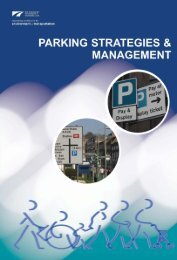Level 2 and 3 Diploma in Business Support (4475-12/13)
Level 2 and 3 Diploma in Business Support (4475-12/13)
Level 2 and 3 Diploma in Business Support (4475-12/13)
You also want an ePaper? Increase the reach of your titles
YUMPU automatically turns print PDFs into web optimized ePapers that Google loves.
3. Importance of st<strong>and</strong>ards of behaviour eg need to act with<strong>in</strong> statutory powers, comply with<br />
common law, be well <strong>in</strong>formed, follow procedure, take legal advice, recognise that all<br />
documentation is potentially <strong>in</strong> the public doma<strong>in</strong>, consult, demonstrate that the process leads<br />
to well-reasoned decisions.<br />
Civil Service Code – to work with <strong>in</strong>tegrity, honesty, objectivity <strong>and</strong> impartiality.<br />
Purpose – eg to ensure organisations behave <strong>in</strong> the way described. ie make well reasoned<br />
decisions, publicise <strong>and</strong> expla<strong>in</strong> their decisions, consult, behave impartially, spend public money<br />
wisely, deliver services efficiently <strong>and</strong> to agreed st<strong>and</strong>ards etc.<br />
Accountability – Managerial accountability -through structural arrangements such as<br />
committee structures, separation of powers (eg small ‘cab<strong>in</strong>ets’ or executive committees <strong>and</strong><br />
scrut<strong>in</strong>y committees <strong>in</strong> local government). Political accountability, to the electorate, <strong>and</strong> to<br />
Parliament .<br />
Outcome 3 Underst<strong>and</strong> the role of the public sector <strong>in</strong> provid<strong>in</strong>g services<br />
<strong>and</strong> how an <strong>in</strong>dividual’s role contributes to provision<br />
1. Customers - different services may use different terms for their customers eg citizens, members<br />
of the public, service users, clients. Patients, residents. Customers may also be funders <strong>and</strong><br />
other organisations that have significant work<strong>in</strong>g relationships with the organisation. Customers<br />
may be <strong>in</strong>ternal or external.<br />
2. Identify needs <strong>in</strong> terms of eg through public consultations, surveys <strong>and</strong> local research, feedback<br />
from service users/customers etc; analysis of relevant data.<br />
1. Expla<strong>in</strong> <strong>in</strong> terms of protect <strong>and</strong> enhanc<strong>in</strong>g organisations reputation, to meet customer needs,<br />
comply with legislation, satisfy quality st<strong>and</strong>ards.<br />
3. Expla<strong>in</strong> In terms of adapt<strong>in</strong>g exist<strong>in</strong>g services, alter<strong>in</strong>g priorities, allocat<strong>in</strong>g staff or resources<br />
differently, <strong>in</strong>troduc<strong>in</strong>g new services.<br />
4. Expla<strong>in</strong> differences <strong>in</strong> terms of eg legally required as opposed to discretionary.<br />
5. Describe <strong>in</strong> terms of eg ensur<strong>in</strong>g the service meets the needs of the diverse client group,<br />
through fair processes, flexibility or special arrangements <strong>in</strong> service delivery, eg translators or<br />
multi-l<strong>in</strong>gual literature.<br />
6. Expla<strong>in</strong> <strong>in</strong> terms of eg to comply with legislation (The Equality Act, apply<strong>in</strong>g frameworks (eg<br />
Equality Framework for Local Government) to protect the organisation from legal action, poor<br />
<strong>in</strong>spection grades etc. To meet the needs of all customers, whatever their gender, age, values,<br />
ethnicity, sexual orientation, special needs or disabilities etc.<br />
7. Describe <strong>in</strong> terms of eg <strong>in</strong> terms of range of experience, underst<strong>and</strong><strong>in</strong>g of the needs of a diverse<br />
population or service user/customer group, draw<strong>in</strong>g on the full range of skills <strong>and</strong> knowledge <strong>in</strong><br />
the workforce when recruit<strong>in</strong>g, act<strong>in</strong>g as positive role models.<br />
8. Expla<strong>in</strong> <strong>in</strong> terms of eg meet<strong>in</strong>g targets, work<strong>in</strong>g efficiently <strong>and</strong> effectively, fulfill<strong>in</strong>g all aspects of<br />
their job role, be<strong>in</strong>g flexible, work<strong>in</strong>g <strong>in</strong>dependently <strong>and</strong> with other people. Through<br />
representative bodies such as staff associations, work councils, trade unions.<br />
Outcome 4 Underst<strong>and</strong> f<strong>in</strong>ances <strong>in</strong> the public sector<br />
1. Sources of fund<strong>in</strong>g: eg through central taxation (eg <strong>in</strong>come tax, VAT, duty on petrol, tobacco<br />
etc), government borrow<strong>in</strong>g, <strong>and</strong> local taxation (bus<strong>in</strong>ess rates, council tax etc), local borrow<strong>in</strong>g<br />
(eg local authorities) fund<strong>in</strong>g to central government revenue rais<strong>in</strong>g by local authorities (park<strong>in</strong>g<br />
fees, hir<strong>in</strong>g of leisure facilities etc.), European Union fund<strong>in</strong>g. How the fund<strong>in</strong>g is made available<br />
ie either directly to the organisation through its own sources or provided through direct grants<br />
176 <strong>Level</strong> 2 <strong>and</strong> 3 <strong>Diploma</strong> <strong>in</strong> Bus<strong>in</strong>ess <strong>Support</strong> (<strong>4475</strong>-<strong>12</strong>/<strong>13</strong>)







